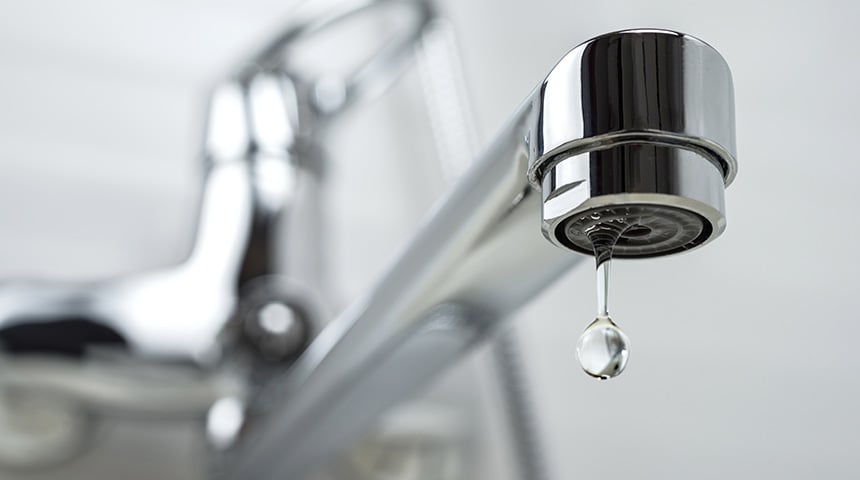Does your washbasin or ktitchen faucet suddenly squeak, or does it keep leaking despite multiple efforts to fix it? If you’re in doubt on whether a simple fix will solve the problem, or if your faucet needs replacing – we put together a simple guide to help you save time, money and water.

While most fixtures are built to last, not everything always goes according to plan. Your kitchen or lavatory faucet might start leaking, squeaking or showing signs of tear. It’s expected, yet we might not always be sure what to do. Call in a professional and get it repaired, or replace the fixture altogether?
And if, like many of us, you are concerned about the environmental impact of replacing your faucet instead of repairing it, bear in mind that a faucet dripping as little as 10 times an hour will waste hundreds of litres of water per month.
A single dripping faucet can waste as much as 20,000 litres of water every year: a substantial amount and a serious environmental concern. And, above all, leaking faucets will be heavy on your wallet too.
A single dripping faucet can waste as much as 20,000 litres of water every year
So, where to start? First, let’s assess whether your faucet is damaged in the first place. Here is what you should be looking out for:
- Leaks or dripping– Leaks can be a common plumbing problem, but if you notice your faucet is constantly dripping, then you have a damaged faucet. Constant dripping is usually caused by broken cartridge or valve.
- Squeaks – If your faucet’s handle squeaks when you turn the water on, there could be damages that need urgent repair. Sometimes a squeaky handle needs a little grease applied. But if that doesn’t work, it’s time to call a plumber.
- Spits – Faucets that function normally should release a consistent stream of water, but if yours has an irregular water flow, there could be some damages. Spitting is usually caused by some sort of internal damage done to the faucet.
When to repair?
Now, if you are experiencing any of the above, let’s look at when the faucet can be repaired. This will spare you from having to invest in an entirely new fixture.
- Frequent dripping or leaking – Leaking and dripping faucets can be repaired. However, given the complexity of the task, we recommend reaching out to a professional to fix a dripping or leaking faucet. Leaks from the faucet body and seams might require the sealing rings to be replaced, while dripping faucets require changing the cartridge – and both tasks need the expertise of a professional.
- Squeaky faucet – Squeaky faucets don’t usually require a replacement. A simple repair will do. Most of the time, removing the appropriate parts and greasing them thoroughly will solve the issue.
When to replace?
Now let’s look at when it’s best to replace your faucet.
Here are a few things to consider:
- Age – We use lavatory and kitchen faucets so frequently that, over time, any fixture is bound to show signs of age. So, if you’ve had the same faucet for years, it might be time for a new one.
- Frequent issues – Given the amount of time we use our faucets, quick repairs won’t always do the job. So, if your fixture keeps giving you problems, consider a replacement that will save you from worrying about imminent malfunctions or potential water damages (and from spending money on constant repairs.)
- Efficiency – Is your faucet not working as it should? Or maybe wasting too much water because it doesn’t include modern water-saving features? Then consider investing in a high-quality faucet that will help you conserve water, keep your bills down and be more sustainable.
- Hygiene – If you believe, on top of all, that your faucet collects too much bacteria and is proving difficult to clean, it may be time to switch to a SMART touchless faucet. Many homeowners are increasingly replacing their manual faucets with SMART touchless faucets as a way to reduce contact with harmful germs and bacterial lingering near their faucet.
- A noisy faucet - If the water flowing through your faucet is particularly noisy, it might be due to the fixture not being of the highest quality. We therefore suggest replacing the faucet with a high quality one where the noise class is 1, which ensures that the water flowing through it does not make any unwanted sounds.
Remember that if you opt for a replacement, make sure to recycle your old fixture. Most faucets are built out of recyclable parts and can be delivered to recycling centres that will ensure the fixture won’t go straight into landfill.
If your faucet is dripping or simply showing signs of age, it’s right for you to assess whether a quick fix will do, or if the fixture needs to be replaced. And with sustainability in mind, remember that a dripping faucet does the environment no good, wasting litres of precious water every day. With a growing number of water-saving technologies and SMART automatic faucets making their way into people’s homes, options for a greener bathroom and kitchen when your fixture needs replacing are within reach.

-block-desktop-860x480.jpg?width=940&name=40210_Hansa_Vantis_Style_Basin01_Hansa_Vari_oh_IR.tif(1)-block-desktop-860x480.jpg)

-block-desktop-860x480%20(1).jpg?width=940&name=Oras_Romantic_V3.jpg(1)-block-desktop-860x480%20(1).jpg)

